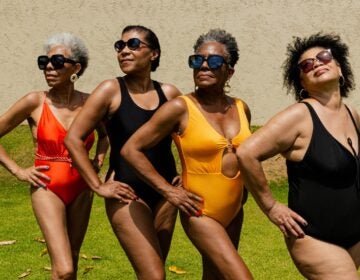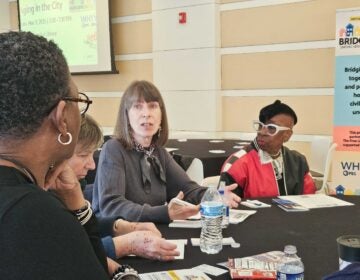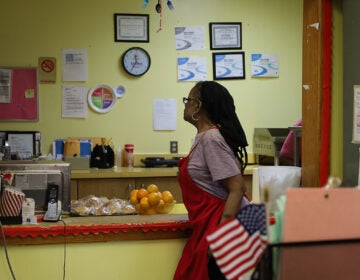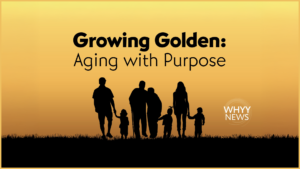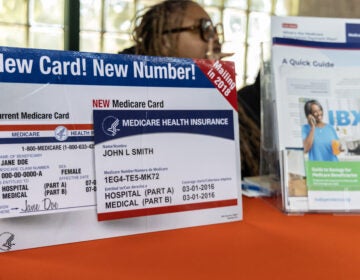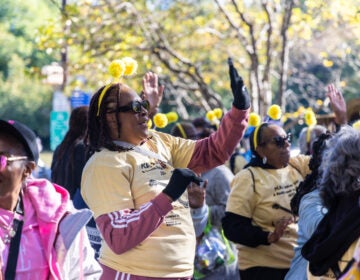Falls are the leading cause of injury among older adults. Here’s what to know
Experts across the region are working to educate older adults on how they can prevent falling as they age.
Listen 1:24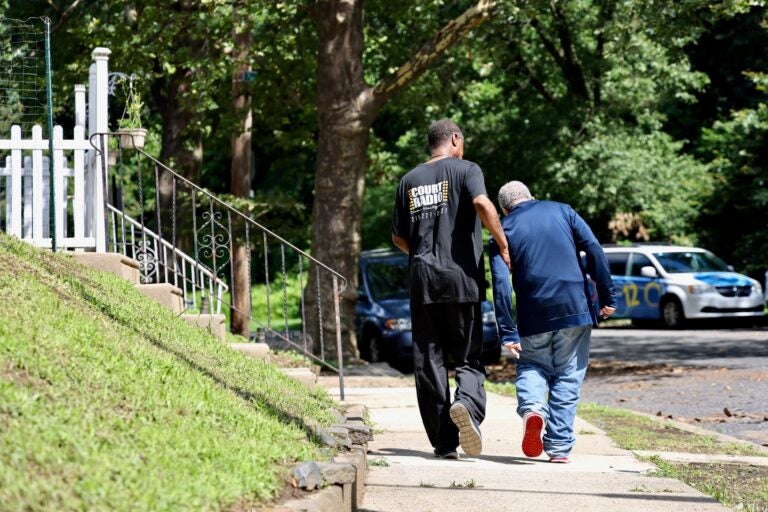
File: Joseph Dennis (left), a volunteer with Philadelphia's Senior Companion Program, walks with James Henry, who is blind and needs assistance leaving the house. (Emma Lee/WHYY)
From Philly and the Pa. suburbs to South Jersey and Delaware, what would you like WHYY News to cover? Let us know!
Montgomery County Coroner Dr. Janine Darby sees thousands of cases of sudden, unnatural or violent deaths come through her morgue each year.
“Some people aren’t breaking bones … but they’re hitting their head,” Darby explained. “We see a lot of the cerebral hemorrhaging causing death, leading to death.”
Of the more than 2,800 cases her office investigated in 2024, falls ranked as the second-most common cause of death after cardiac events.
The vast majority of those deaths were among people 60 and over who fell on level ground, which may sound surprising to many people, Darby said.
“If you were to … ask, what do you think the top three are, I would have never thought falls,” said county Commissioner Tom DiBello when Darby presented the numbers at a commissioners’ meeting in March.
Nationwide, falls are the leading cause of death from injury among older adults. It’s also the No. 1 cause of nonfatal injuries among aging seniors. Accidents can diminish someone’s quality of life or even cut their future short, but health experts say these incidents are preventable.
Across the commonwealth, advocates, state officials, health providers and caregivers are working to increase awareness and find ways to reduce fall risks and their serious or fatal outcomes in older adults.
“We take this very seriously, and it’s not a normal part of growing older,” said Susan Neff, a supervisor at the Department of Aging who leads the Pennsylvania Falls Prevention Coalition. “Most falls can be prevented.”
Why falls are so dangerous — and common — for older adults
More than 2,000 Pennsylvanians died from a fall in 2022, and nearly 63,000 people were hospitalized after a fall, according to data collected by the state Department of Health. Neff said the average cost of those hospitalizations was $86,746.
Falls can cost older adults anything from their life to tens of thousands of dollars in medical bills, and can also hinder their mental well-being, Neff said.
“If someone’s fallen, and they’re worried that they might fall again, that can limit someone’s activity level,” Neff said. “It can lead to depression and hopelessness, a loss of mobility, a loss of functional independence.”
As people age, their bodies become more frail as they lose muscle mass and bone density, which can make even a moderate fall turn into broken or fractured bones, torn ligaments and other serious injuries.
That could put someone on a long road of physical recovery and potentially involve other long-term health complications, said Dr. Ankur Patel, a geriatrician, author and president of the Inspira Living Independently for Elders, or LIFE, program in South Jersey.
“When you are in a hospital, you are sitting in the bed, your mobility significantly decreases,” he said. “Muscles are something you use or you lose.”
Elevated risks for falls go beyond an aging body, Patel said. Different medications for chronic diseases can also affect someone’s balance and alertness and increase their chances for injury.
Vision issues can also be a culprit, he said.
“A lot of times, people don’t connect the dots and they always think it’s because they’re getting weak. But when was the last time you did a vision test?” Patel said.
What to do to prevent falls
The Department of Aging and the Falls Prevention Coalition work to address falls as “a public health issue for everyone,” Neff said, by providing evidence-based falls prevention programs in partnership with each county’s area agency for aging.
Neff said a good place to start to identify your fall risk and how to protect against it is by taking the department’s Healthy Steps for Older Adults class. The fall risk screening and prevention program for adults 50 and older is available in English and Spanish.
Here are what experts recommend doing to prevent falls:
Speak to your medical provider
A primary care doctor can evaluate fall risk, Neff said, and a health provider or pharmacist can review the prescriptions and over-the-counter medications that could increase the risk of falling.
Doctors can also talk about any calcium or vitamin D supplements that could help increase bone density and strength, and can review any cognitive or memory issues.
“We find that confusion and mental confusion can lead to a fall in many cases,” Neff said. “So those are important things to do.”
Get a home assessment
The LIFE program in South Jersey regularly conducts home evaluations and assessments to help people make adjustments to their living environment. Patel said prevention can be as simple as removing clutter and tripping hazards like loose wires connected to appliances or electronic devices.
It can involve pushing furniture closer to the edges of a room to create wider walking spaces, adding railings and bars to hold onto for stability and ensuring areas are well lit, especially at night.
Pennsylvania residents can also contact their area agency for aging for information on home assessments and to find resources and even financial support for adding safety features to their homes.
Health providers and caregivers can also do a better job at supporting their loved ones to age in place at home while encouraging them to still report falls and accidents, Patel said.
“The reason a lot of times they don’t tell about it is because they think, ‘If I’m falling and if I tell my doctor or my caregiver, I will lose my independence,’” he said.
Evaluate your health routine
Smart everyday decisions around diet, exercise and safety can play a big role in preventing falls, Neff said.
A healthy, balanced diet and regular vision and hearing checks are all important.
Neff said particularly for older adults, it’s important to see a podiatrist for any foot issues.
“We see a lot of people falling because they have neuropathy in their feet and their lower leg,” she said.
Older people should ensure they’re wearing proper footwear on a daily basis and using mobility devices correctly, Patel said.
“If the cane is not the appropriate length or the walker, and they are not using it appropriately, they are at a higher risk of fall,” he said.
Finally, doing strength and balance exercises can help prevent falls.
Neff said that Pennsylvania adults 60 and older can enroll in the state’s Healthy Steps in Motion class, which builds participants’ strength, balance and flexibility.
Regular exercise and training, even in small amounts, Patel said, can help maintain muscle mass, strength and balance.
“Just sitting in the chair, stand up, sit down, stand up, sit down five to 10 times, twice a day,” he said. “Those are the little things you can do.”
The importance of asking for help
As the Montgomery County coroner, Darby usually deals with the people most gravely impacted by falls, and the loved ones that survive them.
But as a doctor who previously practiced primary care medicine, she sees it as her role to flip the script and push prevention.
“That’s something that we want to work on this year,” she said. “So usually getting out to maybe nursing homes, assisted living.”
She said falls prevention for older adults can sometimes be as simple as the people around them offering support, and older adults being willing to accept it and ask for help.
“As we get old, we get even ornery and stubborn,” she said. “We don’t want to listen, we don’t want to walk with a cane because we’re prideful … Some people may need a wheelchair and scooters and all of that, but our pride also gets in the way, right? That’s where we see the falls.”

Get daily updates from WHYY News!
WHYY is your source for fact-based, in-depth journalism and information. As a nonprofit organization, we rely on financial support from readers like you. Please give today.


